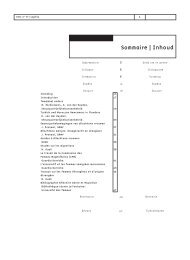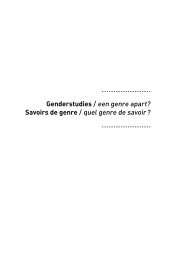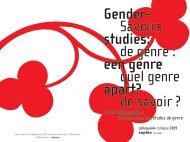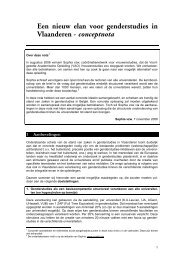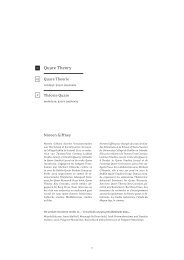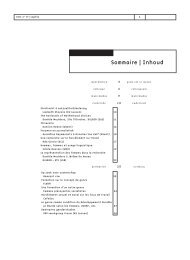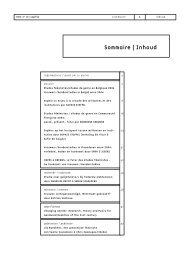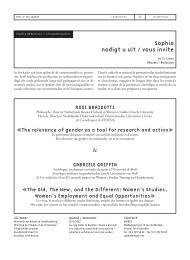Nieuwsbrief 32 (pdf) - Sophia
Nieuwsbrief 32 (pdf) - Sophia
Nieuwsbrief 32 (pdf) - Sophia
Create successful ePaper yourself
Turn your PDF publications into a flip-book with our unique Google optimized e-Paper software.
echerche<br />
38<br />
onderzoek<br />
sophia | n° <strong>32</strong> | 2002<br />
thèse de doctorat<br />
Are Women in Parliament Representing Women?<br />
From Descriptive to Substantive Representation…<br />
And Back Again?<br />
Mercedes Mateo Diaz, UCL<br />
The issue of equality is at the centre of<br />
theoretical and practical discussions in<br />
modern democracies. Most political<br />
actors agree that the State shall treat its<br />
citizens equally, in the sense that it shall<br />
not suppress individuals due to certain<br />
physical characteristics, such as race, or<br />
sex. Political controversy arises over what<br />
is to be done so as to prevent inequalities<br />
from developing. At issue, is the extent to<br />
which governments should promote, e.g.<br />
political, social and economic equality,<br />
through policies of redistribution and<br />
affirmative actions, in order to reach greater<br />
levels of equality.<br />
One common claim to equality stipulates<br />
that it is enough to provide equal<br />
opportunities, i.e. the State ought to protect<br />
its citizens against discriminating treatments.<br />
Another approach to equality<br />
maintains that it can not be realized by<br />
giving equal opportunities to citizens.<br />
Those who support the second approach,<br />
maintain that equal opportunities<br />
can result in unequal outputs, given that<br />
the starting point - in terms of capabilities,<br />
training, information, and other random<br />
factors, do not hold constant. From<br />
this second approach, not only is the<br />
input valued, but the output is also considered,<br />
in the assessment of the system’s<br />
equality capacities.<br />
I do not, of course, claim to give a definite<br />
answer to the issue of the State’s role<br />
in the promotion of equality among its<br />
citizens. Regarding these issues, my aim<br />
here is somewhat more modest. It is to<br />
attempt to incorporate a stronger empirical<br />
basis to some of those theoretical,<br />
and political, arguments and tools that<br />
are proposed. Proposed and used, in some<br />
cases, regarding the political representation<br />
of a group of citizens – those sharing<br />
certain physical characteristics, namely<br />
women.<br />
The issue of political<br />
inequality<br />
Political inequality, as related to the right<br />
to vote and to stand for election, together<br />
with broader socio-economic inequalities,<br />
have resulted in a disproportionate<br />
composition (according to certain<br />
characteristics) of the legislative assemblies.<br />
During the first half of the 20th<br />
century women were allowed to enter the<br />
voting booth in a majority of the Western<br />
European countries. To a larger extent<br />
during the last quarter of the century<br />
women came to participate in the work<br />
carried out in different political and socioeconomic<br />
spheres. Still, today, a majority<br />
of the national assemblies remain basically<br />
unrepresentative of the major<br />
socio-economic components of society, to<br />
the point that political representation has<br />
been said to have an "aristocratic character"<br />
(Manin, 1996), and the parliament's<br />
composition to be biased (Norris<br />
& Lovenduski, 1995).<br />
The decades of the 1970s and 1980s have<br />
seen the emergence of 'new social movements'<br />
or 'new political identities', which<br />
has resulted in a growing saliency of socalled<br />
politics of 'identity/difference'<br />
(Cohen, 1996). In line with this focus<br />
on politics of ‘identity/difference’ numerous<br />
different mechanisms have been pr<br />
posed for enhancing the representation of<br />
different groups.<br />
Besides the argument that groups with<br />
different characteristics simply have a<br />
right to have a proportional representation,<br />
several arguments have also been<br />
advanced on the benefits of such a proportional<br />
representation. Among the latter<br />
type of arguments are those which<br />
claim that women will bring a renewal<br />
of the political culture, and a substantive<br />
change in legislative outputs. Therefore,<br />
since women have reached balanced<br />
proportions in the Nordic parliaments<br />
there has been a need to study if, how<br />
and when new groups of actors in the<br />
political arena (can) actually change institutions<br />
and the outputs which have issued<br />
from them.<br />
The study is focused on three major empirical<br />
questions, i.e. What affects women's<br />
presence in parliaments?, Does the<br />
number of women in parliament have an<br />
effect? and Are women in parliament<br />
representing women?. Each of these<br />
questions is discussed in a theoretical<br />
chapter, which forms the basis of the corresponding<br />
empirical section. The object<br />
of this study is the national parliaments<br />
of the 15 European Union Member States,<br />
and more specifically, in countries<br />
with a bicameral system, the lower house.<br />
I will not address here any methodological<br />
considerations, such as the data<br />
used, or technical issues concerning the<br />
analyses. I will rather concentrate on the<br />
discussion of substantive issues and the<br />
empirical findings of each one of the three<br />
sections.




